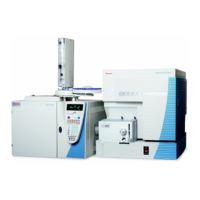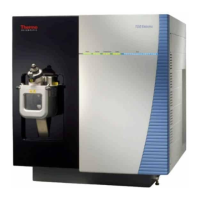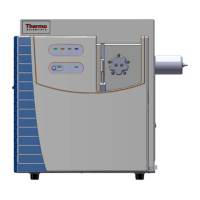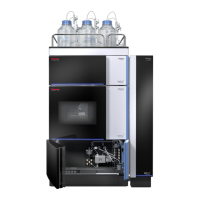1
Introduction
Ionization Modes
Thermo Scientific TSQ Series Hardware Manual 3
Ionization Modes
The atmospheric pressure ionization (API) source forms gas phase sample ions from sample
molecules that elute from the LC or are introduced by the syringe pump. You can operate the
API source in the electrospray ionization (ESI) mode or, optionally, the heated electrospray
ionization (H-ESI), nanospray ionization (NSI), atmospheric pressure photo ionization
(APPI), or atmospheric pressure chemical ionization (APCI) mode. Refer to the Ion MAX
and Ion MAX-S API Source Hardware Manual, HESI-II Probe User Guide, H-ESI Probe User
Guide, Ion MAX APPI Source Operator’s Manual, or Nanospray Ion Source Operator’s Manual
for more information regarding the ionization modes.
Ion Polarity Modes
You can operate the TSQ mass spectrometer in either of two ion polarity modes: positive or
negative. Both positively charged and negatively charged ions form in the ion source of the
mass spectrometer. The TSQ mass spectrometer can control whether positive ions or negative
ions are transmitted to the mass analyzer for mass analysis by changing the polarity of the
potentials applied to the ion source and ion optics. The ion optics deliver the ions produced
in the ion source, in a collimated beam, to the mass analyzer.
The information obtained from a positive ion mass spectrum is different from and
complementary to the information from a negative ion spectrum. Thus, the ability to obtain
both positive ion and negative ion mass spectra aids you in the qualitative analysis of your
sample. You can choose the ion polarity mode and ionization mode to obtain maximum
sensitivity for the particular analyte of interest.
Scan Modes
You can operate the TSQ mass spectrometer in a variety of scan modes. The most commonly
used scan modes can be divided into two categories: single mass spectrometry (MS) scan
modes and MS/MS scan modes. The scan modes in each category are as follows:
• MS scan modes: Q1MS and Q3MS scan modes
• MS/MS scan modes product scan mode, parent scan mode, neutral loss scan mode
• Data-dependent scan mode
The scan modes that can be employed depend on the number and type of rod assemblies and
the voltages applied to the rod assemblies.

